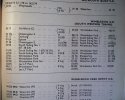If you want to know more about the stabling (if any) in the Dundonald Road siding (not something I was ever involved in as it was a Central Div location for operational purposes) certainly in my SW days, you need to find a copy of a Central Div 'Carriage Working Notice for Electric trains', (not just the 'Appendix to the Carriage Workings' which won't give that sort of detail), applicable to one of the years you are interested in. Proper CWN's for sale seem to be thin on the ground on the web these days. There is one chap (jtpend? type in 'Carriage Working Notices' on the Bay) but most of those he is selling are fascimilies, and again mostly of Appendix to CWN, and /or steam era stuff. Have even noticed some fascimilies of documents I had a hand in producing - how bizarre!
If you want to know more about the stabling (if any) in the Dundonald Road siding
Further to above. there's no certainty that this siding will be shown in the CWN. If it was only used for Short term reasons, ie Engineering works turn back moves, that will have only been reflected in the Altered Carr Working Notices (ACWN's), which were paper (hand written or at best typed) documents issued just for the day of operation, and so binned afterwards as a rule.
Have no idea if you are familiar with the format of the CWN's or not, but have attached pages from the SW edition (SX days - Wimbledon station) showing the moves involving the SW South Siding 1 as also spoken of.
If I'm preaching to the converted, please forgive me!
The inbound workings (to the station in the title) are on the right hand side, and the outgoing service they form next/next day, on the left hand side, and all are arranged in departure time (left side) order. There is a very good reason for this, but I won't digress here.
The May 1973-May 74 edition only involves 3 x 8 SUB sets, so the siding wasn't full, the first leaves the siding at 06+18 (+ refers to an empty/ECS train) arriving in platform 8 at 06+19, and forms the 06 20 1/2 to Chessington. Half minutes in timings schedules
at starting and terminal locations were done away with in later years.
The next departure is shown from 'Berth, South Sidings' - the reason for this being it is an empty train from the siding all the way to Chessington, so no need to show its passing time at Wimbledon p8. Likewise the third departure which leaves the siding at 07+56 and empty to Epsom. In later (Computer era) days, because the way computer programmes work, every actual location where a train started/finished or reversed had its own entry, which Wimbledon South Sidings would have had, had they still been used.
Between the peaks one 8 car SUB makes use of the siding, arriving Wimbledon P8 10+03 (09+50 from Waterloo), and departs P8 at 10+05 in to the siding. In modern times (with empty trains DOO) a two minute reversal would not be permitted in normal circumstances as the driver would have to change ends (5 or 6 mins for an 8 car IIRC which wouldn't work within the timetable due to frequency of other services through p8) and drive from the leading cab at all times, but back then the guard would still be on the train, and will likely have ridden in the London end cab to oversee the move in to the siding, the driver propelling same from the country end cab, unless a second relieving driver was diagrammed for the shunt?
This train then leaves the siding again at 16+06 and runs empty to Chessington.
The first 8 SUB to stable every night is the 20+20 from Waterloo, due Wimbledon p8 at 20+33, and shunting in to South Siding at 20+36, and it would have to run towards the London end of the siding to allow the other two 8 cars to arrive in behind. Its next working was the 07+56 next SX day - as above - first in/last out. The previous working of this set was a parcels train from Epsom to Waterloo, which sat at Waterloo for a half hour, where arrangements would have been in place to have the units swept out/litter picked.
The remaining two sets trip over from Wimbledon Depot, as I mentioned up thread, the first at 21+30 from the depot (for 06+36 next SX day), the last at 22+30 for 06+18 next SX day (last in/first out).
These were designed to stand spare at weekends, for the simple reason that many units were not needed, unless for engineering work purposes, and it was/is easier from a crewing point to use units stabled within depots and at locations more readily accessible for crews.
By comparison the second image of the same location relates to May 1978-May 79, when a number of EPB's have now replaced many SUB's.


